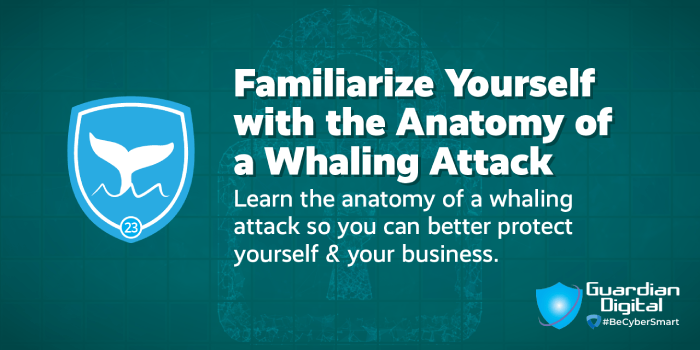Tip - Familiarize Yourself with the Anatomy of a Whaling Attack

Learn the anatomy of a whaling attack so you can better protect yourself & your business.
You’ve seen phishing attacks, but what about whaling, a variation of phishing that targets high profile executives, or “whales”?
Executives have all access to sensitive data and ability to authorize high-value wire transfers to make them valuable attack targets.
To defend against whaling, knowledge is power, so let Guardian Digital educate you on the anatomy of a whaling attack.
Watch: Anatomy of a Whaling Attack
Anatomy of a Whaling Attack
Phase 1: Research
Cybercriminals invest extensive time into researching targets to make their fraudulent emails as deceptive as possible.
Attackers get information from data breach and websites to build their target list by identifying key executives and their relationships.
Higher-ups are more publicized online with bios on websites and networking information that gives cybercriminals easy research.
Phase 2: Build Attack
Attackers manipulate human psychology to develop convincing emails impersonating good colleagues of targeted higher-ups.
Cybercriminals portray authority figures of a target organization or partnering company to have good odds of convincing a higher-up.
Phase 3: Launch Campaign
Cybercriminals launch whaling campaigns targeting high profile executives they’ve identified in their target list with spoofing.
Some use malicious links to download malware or direct the victim to a fake website login page requesting a username and password.
Phase 4: Reap Rewards
Urgency and trust convince the victim to proceed with the request in the malicious email to cause a data breach or significant financial loss.
Some threat actors gain access to the higher-up’s email address to impersonate them using their actual accounts to deceive all employees.
Whaling - a $12.5 billion scam! - results in fraudulent wire transfers and reputation harm.
How Can I Secure Business Email Against Whaling Attacks?
Our email security solution finds and intercepts whaling threats, mitigates risk and provides your organization with peace of mind.
Guardian Digital EnGarde Cloud Email Security’s technology proactively learns and distributes defenses for specific threats targeting you.
Want to see EnGarde in action? Get a Live Demo>>
CyberSecurity Month
- Tip - Avoid Phishing Emails
- Tip - Being Cautious of Spam Email
- Tip - Be Wary of Malicious URLs
- Tip - Protect Against Spoofing & Sender Fraud
- Tip - Protect the Privacy of Your Email with TLS
- Tip - Don't Rely on Native Microsoft 365 Email Protection Alone
- Tip - Implement TLS to Keep Your Email Secure
- Tip - Endpoint Security Is Not Enough
- Tip - Conduct Regular Email Security Audits
- Tip - Configure Email Account Settings with Security in Mind
- Tip - Learn How To Spot Threats to Business Email
- Tip - Backing up Your Data and Isolate Your Backups Offline
- Tip - Protect Business Email from Phishing Attacks
- Avoid Sending Sensitive Information Over Email
- Tip - Learn About Malicious Links
- Tip - Prevent Zero-Day Attacks
- Tip - Business Email Is for Business Only
- Tip - Learn How To Identify Social Engineering Attacks
- Tip - Know Your Email Risk
- Tip - Safeguard Your Inbox from Malicious Mail
- Tip - Understand How Phishing Attacks Are Carried Out
- Tip - Know the Steps in a Spear Phishing Attack
- Tip - Familiarize Yourself with the Anatomy of a Whaling Attack
- Tip - Understand How Malware Attacks Work
- Tip - Learn the Steps in a Ransomware Attack
- Tip - Understand the Phases of a Business Email Compromise (BEC) Attack
- Tip - Know What Zero-Day Attack Is & How It Works
- Tip - Familiarize Yourself with the Phases of an Account Takeover (ATO) & Lateral Phishing Attack
- Tip - Learn the Steps in a Social Engineering Attack
- Tip - Understand the Types of Email Viruses to Be on the Lookout For